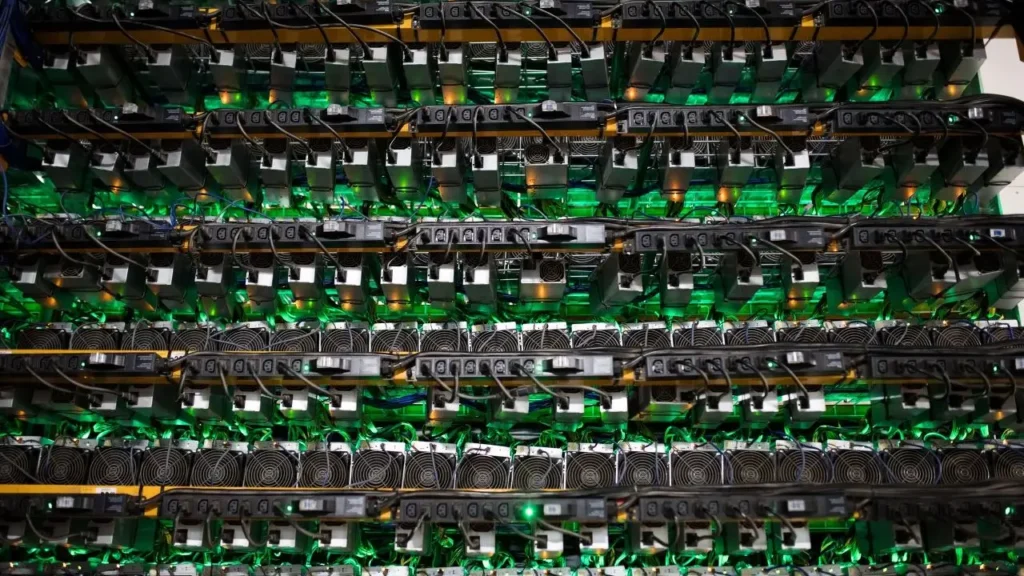Bitcoin Mining: Unveiling the Process Behind Cryptocurrency Creation

Table of Contents
In the dynamic world of digital finance, few innovations have captured the imagination and intrigue of the public quite like Bitcoin. As the pioneer of cryptocurrencies, Bitcoin has not only disrupted traditional financial systems but has also sparked a global revolution in the way we perceive and exchange value. At the heart of this decentralized digital currency lies an enigmatic process known as “Bitcoin mining,” which lies at the core of the cryptocurrency’s creation and security.
In this article, we delve deep into the fascinating world of Bitcoin mining, uncovering the intricate mechanics that underpin this revolutionary process. From its humble beginnings to becoming a multi-billion-dollar industry, we aim to demystify the complex algorithms and concepts behind Bitcoin mining and explore how it drives the entire cryptocurrency ecosystem.
What is Bitcoin Mining and How Does It Work?
Bitcoin mining is the process by which new Bitcoins are introduced into circulation and transactions are verified and added to the blockchain, the public ledger of all Bitcoin transactions. Unlike traditional currencies that are issued and regulated by a central authority, Bitcoin operates on a decentralized network of computers, making use of a consensus mechanism known as Proof of Work (PoW).
The mining process involves miners using powerful computer hardware to solve complex mathematical puzzles. These puzzles are essential to validate and confirm the legitimacy of transactions in the Bitcoin network. Miners compete against each other to solve these puzzles, and the first one to find the correct solution gets to add a new block of transactions to the blockchain.
To understand how it works, picture the blockchain as a series of interconnected blocks, with each block containing a set of transactions. Miners bundle these transactions into blocks and use their computational power to perform calculations that secure the network. The process of solving these puzzles is energy-intensive and requires significant computational resources.

Understanding the fundamental concept of Bitcoin mining
The fundamental concept behind Bitcoin mining is the Proof of Work consensus algorithm. This concept was introduced by Bitcoin’s creator, Satoshi Nakamoto, to address the issue of trust and security within a decentralized system. Proof of Work ensures that miners invest computational power and energy into validating transactions, making it prohibitively costly for malicious actors to attempt fraudulent activities on the network.
The concept of mining also introduces scarcity to Bitcoin. The maximum supply of Bitcoin is capped at 21 million, and as miners continue to mine new Bitcoins, the process becomes progressively more challenging. This difficulty is dynamically adjusted by the network every 2016 block, or roughly every two weeks, to maintain a stable block generation time of approximately 10 minutes.
Through mining, Bitcoin achieves both decentralization and trustless verification. No single entity has control over the network, and all participants can verify transactions without relying on a central authority. This feature has been pivotal in establishing Bitcoin as a digital store of value and a medium of exchange, gaining acceptance across the globe.
Role of miners in the creation and validation of new Bitcoins
Miners play a crucial role in the creation and validation of new Bitcoins. As mentioned earlier, the mining process involves solving complex mathematical puzzles, and the first miner to solve the puzzle gets to add a new block to the blockchain. As a reward for their efforts, the successful miner is granted a specific number of newly minted Bitcoins, along with transaction fees paid by users for including their transactions in the block.
This process is often likened to a lottery, as miners must compete against each other to find the correct solution. The more computational power a miner contributes to the network, the higher their chances of successfully mining a new block and earning the associated rewards.
However, as the mining process becomes more competitive and resource-intensive, individual miners have found it increasingly challenging to mine profitably. As a result, mining pools have emerged, allowing miners to combine their computational resources and increase their chances of earning rewards.
The Blockchain Technology Backbone
Bitcoin, the revolutionary digital currency, owes its existence and operation to the ingenious technology of blockchain. In essence, the blockchain is a distributed and decentralized ledger that records all transactions made with Bitcoin. Unlike traditional financial systems that rely on centralized authorities like banks, the blockchain operates on a peer-to-peer network of computers, each contributing to the security and integrity of the network.
Exploring the blockchain’s critical role in the Bitcoin network
At the core of the Bitcoin network lies the blockchain, which serves as an unchangeable, chronological chain of blocks. Each block contains a batch of transactions that have been verified and agreed upon by the network participants. These transactions are bundled together in a cryptographically secure manner, making it practically impossible to alter the data in any individual block without changing all subsequent blocks. This tamper-resistant characteristic ensures the immutability of the data, establishing trust and integrity in the system.
When a user initiates a Bitcoin transaction, it is broadcasted to all nodes (computers) in the network. The miners, which are powerful computers with specialized hardware, play a vital role in securing the network and validating these transactions. Mining, in the context of Bitcoin, refers to the process of adding new blocks to the blockchain by solving complex mathematical puzzles.
Miners compete to be the first to solve the puzzle because the first miner to do so gets to add the next block of transactions to the blockchain and is rewarded with newly minted Bitcoins and transaction fees. This process of competitive mining is known as the Proof-of-Work (PoW) consensus mechanism and is crucial for maintaining the security and decentralization of the Bitcoin network.
How decentralized ledger technology ensures security and transparency
The decentralized nature of the blockchain ensures security and transparency in the Bitcoin network. Traditional centralized systems are vulnerable to single points of failure, making them susceptible to hacking, fraud, and manipulation. In contrast, the decentralized nature of the blockchain means that there is no single point of control or failure, making it highly resilient to attacks.
To alter any transaction on the blockchain, an attacker would need to control the majority of the network’s computing power, a feat that becomes increasingly difficult as the network grows and becomes more decentralized. This level of security is critical in maintaining the trust of users in the Bitcoin network and preserving the value of the cryptocurrency.
Additionally, the transparency provided by the blockchain is unparalleled. Every transaction is recorded on the public ledger and is accessible to anyone. While the identities of the parties involved in the transactions are pseudonymous (represented by alphanumeric addresses), all transaction details are visible. This transparency not only ensures accountability but also makes it easier to track and trace any suspicious activities on the network.
Mining Hardware: Unearthing the Powerhouse
Bitcoin mining, the process by which new bitcoins are created and transactions are verified, is a fundamental pillar of the cryptocurrency’s existence. Behind this intriguing process lies a critical component that determines the success and efficiency of mining operations – mining hardware. In this article, we delve into the world of specialized mining hardware, exploring the technological advancements that have revolutionized the mining landscape.
A closer look at the specialized hardware used for mining
The early days of Bitcoin mining saw enthusiasts utilizing their computer’s Central Processing Units (CPUs) to validate transactions and earn new bitcoins as rewards. However, as the network grew and the mining difficulty increased, CPUs proved to be inadequate in handling the intensive computational requirements. Miners quickly sought more powerful alternatives, leading to the rise of Graphics Processing Units (GPUs).
GPUs, designed for rendering high-quality graphics in video games, provided superior performance and enabled miners to process more transactions, significantly increasing mining efficiency. This era of GPU mining saw a surge in participation, with miners setting up multiple GPUs to form mining rigs, ultimately forming the first mining farms.
From CPUs to ASICs: Evolution and efficiency of mining equipment
The evolution of mining hardware continued as the demand for faster and more energy-efficient mining solutions intensified. This progression brought forth a game-changer in the world of cryptocurrency mining: Application-Specific Integrated Circuits (ASICs). Unlike CPUs and GPUs, which are general-purpose processors, ASICs are purpose-built solely for mining cryptocurrencies like Bitcoin.
The advent of ASICs marked a groundbreaking turning point in the industry. These highly specialized chips dramatically outperformed their predecessors, offering unmatched processing power while consuming significantly less energy. Consequently, mining operations experienced exponential growth in hash rates and overall network security.
ASICs enabled mining farms to reach unprecedented levels of efficiency and scale. Large-scale mining facilities emerged, equipped with rows upon rows of these powerful machines working in unison to process transactions and secure the Bitcoin network. This proliferation of ASIC-based mining farms further drove the mining difficulty upward, effectively making CPU and GPU mining obsolete for Bitcoin.
Energy Consumption and Environmental Concerns

One of the primary concerns surrounding Bitcoin mining is its massive energy consumption. As the mining process involves solving complex mathematical puzzles through computational power, miners compete to be the first to find the solution and add a new block to the blockchain. This process requires an enormous amount of computational power, which, in turn, demands substantial electricity usage.
Critics argue that the energy consumption associated with Bitcoin mining is excessive and contributes to environmental degradation. Mining operations often rely on fossil fuels, such as coal and natural gas, to power their mining rigs. The burning of these non-renewable resources releases greenhouse gases, which intensify climate change and global warming.
Analyzing the environmental impact of Bitcoin mining
Measuring the exact environmental impact of Bitcoin mining can be challenging due to the decentralized nature of the process and the variety of mining setups worldwide. Nevertheless, several studies have attempted to estimate its carbon footprint.
According to a study published in the journal “Nature Communications” in 2019, Bitcoin mining alone could raise global temperatures by two degrees Celsius within the next few decades if left unchecked. This is a cause for concern, considering the international effort to limit global warming and its catastrophic consequences.
The geographical location of mining operations also plays a role in their environmental impact. In regions where electricity is predominantly sourced from renewable energy, such as hydroelectric, solar, or wind power, the carbon footprint of mining is significantly lower. Conversely, areas, where fossil fuels are the primary energy source, may contribute more to environmental damage.
Renewable energy initiatives and their role in sustainable mining practices
Amid the growing concerns over Bitcoin mining’s environmental impact, the industry has begun to explore renewable energy alternatives to power mining operations. Renewable energy initiatives are gaining traction as a means to foster sustainable mining practices and reduce the carbon footprint associated with the creation of cryptocurrencies.
Several forward-thinking mining companies have started relocating their operations to regions with abundant access to renewable energy sources. Countries like Iceland and Canada, for example, offer low-cost electricity powered mainly by renewable resources, making them attractive destinations for environmentally-conscious miners.
In addition to relocating, some mining facilities have started integrating renewable energy sources into their existing setups. By harnessing solar panels, wind turbines, or hydroelectric power, these mining operations can offset their reliance on fossil fuels and reduce their environmental impact significantly.
Furthermore, innovative technologies and protocols are being developed within the blockchain space to address the environmental concerns associated with mining. Some projects are exploring the concept of “proof-of-stake” instead of “proof-of-work,” which would require significantly less energy for verifying transactions and creating new coins.
Mining Rewards and Halving: The Economics of Incentives

Bitcoin mining serves a twofold purpose: it ensures the integrity and security of the Bitcoin network while also minting new Bitcoins as rewards for miners’ efforts. Miners play a pivotal role in verifying transactions, grouping them into blocks, and adding them to the blockchain. In return, they receive rewards in the form of freshly minted Bitcoins and transaction fees paid by users for their transactions to be prioritized.
Also, read: Understanding Bitcoin: The Rise of Digital Currency
Explaining block rewards and transaction fees for miners
When a miner successfully adds a new block to the blockchain, they are rewarded with a certain number of Bitcoins. Initially set at 50 Bitcoins per block, the block reward undergoes a process known as “halving” approximately every four years. This means that the reward is halved, reducing it by 50%. The halving mechanism is a deliberate design in the Bitcoin protocol to control the supply of new coins and mimic the scarcity of precious metals like gold.
Aside from block rewards, miners also earn transaction fees. Whenever a user initiates a Bitcoin transaction, they have the option to include a transaction fee, which serves as an incentive for miners to prioritize their transaction. Miners will naturally choose transactions with higher fees since it increases their potential earnings. Consequently, during times of high network congestion, users may choose to include a higher fee to expedite their transactions.
The Bitcoin Halving phenomenon and its impact on miners’ profitability
The Bitcoin halving phenomenon has a profound impact on miners’ profitability and the overall supply of Bitcoins in circulation. As mentioned earlier, every four years (specifically after every 210,000 blocks mined), the block reward is halved. This scarcity mechanism has a deflationary effect on the cryptocurrency, making it more challenging to mine new coins over time.
For instance, the first Bitcoin halving occurred in 2012, reducing the block reward from 50 to 25 Bitcoins. The second halving took place in 2016, further reducing the reward to 12.5 Bitcoins. The most recent halving occurred in 2020, cutting the reward to 6.25 Bitcoins.
As the block reward decreases, mining becomes less profitable for individual miners, especially those operating with less efficient hardware or in regions with high electricity costs. Miners have to balance their operational expenses, such as electricity and hardware maintenance, against the diminishing block rewards.
On the positive side, the reduced supply of new Bitcoins brought about by halving events can lead to increased scarcity, potentially driving up the price of Bitcoin in the long run. This price appreciation could offset the reduced block rewards and provide miners with ample incentives to continue their mining activities.
Challenges and the Future of Bitcoin Mining
- Energy Consumption: One of the significant challenges of Bitcoin mining is its energy-intensive nature. As the network grows and more miners join the race, the computations become more complex, demanding increased computational power. This results in higher consumption of electricity, leading to concerns about the environmental impact of mining activities.
- Hardware Costs: To stay competitive, miners need to continuously upgrade their hardware. The latest and most powerful mining rigs come at a substantial cost, making it difficult for small-scale miners to compete with large mining pools.
- Centralization: Over time, Bitcoin mining has become concentrated in the hands of a few major mining pools. This centralization raises concerns about the potential for collusion, censorship, and the possibility of a 51% attack where a single entity gains control of the majority of the network’s computing power.
Also, read: Exploring Ether: Unraveling the Mysteries of the Ethereum Blockchain
Potential shifts to alternative consensus mechanisms: Proof-of-Stake (PoS)
- Ethereum’s Transition to PoS: Ethereum, the second-largest cryptocurrency, has been working on a transition from the energy-intensive proof-of-work to the more eco-friendly proof-of-stake consensus mechanism. Ethereum 2.0 aims to improve scalability, security, and sustainability by allowing validators to create blocks and validate transactions based on the number of coins they hold and are willing to “stake” as collateral.
- Reduced Energy Consumption: Unlike proof-of-work, where miners compete using computational power, proof-of-stake relies on validators who are chosen to create blocks based on the amount of cryptocurrency they “stake.” This significantly reduces the energy consumption associated with mining.
- Encouraging Long-term Investment: Proof-of-stake encourages users to hold and “stake” their coins in the network, as this increases their chances of being chosen as validators. This promotes a higher level of participation and long-term investment in cryptocurrency.
FAQS
Q: What is Bitcoin mining?
A: Bitcoin mining is the process by which new bitcoins are created and transactions are verified and added to the blockchain ledger. It involves solving complex mathematical problems using computational power.
Q: How does Bitcoin mining work?
A: Miners use powerful computers to compete in solving cryptographic puzzles. The first miner to find a valid solution gets to add a new block of transactions to the blockchain and is rewarded with newly minted bitcoins as well as transaction fees.
Q: Why is mining necessary for creating bitcoins?
A: Mining serves two main purposes: first, it allows new bitcoins to be introduced into circulation, ensuring a controlled and decentralized supply. Second, it secures the network by validating and confirming transactions.
Q: What is the role of miners in the Bitcoin network?
A: Miners act as the backbone of the Bitcoin network. They validate and timestamp transactions, preventing double-spending, and help maintain the integrity and security of the blockchain.
Q: How do miners validate transactions?
A: Miners collect unconfirmed transactions from the network and include them in a candidate block. They then attempt to find a unique cryptographic hash that matches specific criteria based on the previous block’s hash, known as Proof-of-Work (PoW). This process validates the transactions and creates a new block.
Q: What is Proof-of-Work (PoW)?
A: Proof-of-Work is a consensus mechanism used by Bitcoin and many other cryptocurrencies. Miners must expend computational power to solve complex mathematical problems, proving that they have done the work to validate transactions and create new blocks.
Q: Are there any rewards for Bitcoin miners?
A: Yes, miners receive two types of rewards. First, they receive a fixed number of newly minted bitcoins with each new block they add to the blockchain. Second, they also collect transaction fees from users who want their transactions prioritized.
Q: How does mining difficulty affect the process?
A: Mining difficulty refers to the complexity of the mathematical problems miners need to solve. It is adjusted regularly to maintain a consistent block creation time. As more miners join the network, the difficulty increases, and vice versa.
Q: Is Bitcoin mining profitable for individuals?
A: It can be profitable, but it depends on several factors, such as the cost of electricity, the efficiency of mining hardware, and the current Bitcoin price. Mining has become more competitive, requiring significant investments in specialized hardware and access to cheap electricity to be profitable.
Q: Does Bitcoin mining have any environmental impact?
A: Yes, Bitcoin mining consumes a considerable amount of electricity due to the computational power required. As a result, it has drawn criticism for its environmental impact, particularly if the electricity used is derived from non-renewable sources.
Q: Will there ever be a limit to the number of bitcoins that can be mined?
A: Yes, the total supply of bitcoins is capped at 21 million. This limit ensures scarcity and is programmed into the Bitcoin protocol. As mining continues, the number of new bitcoins created per block decreases over time, following a predictable halving schedule.




